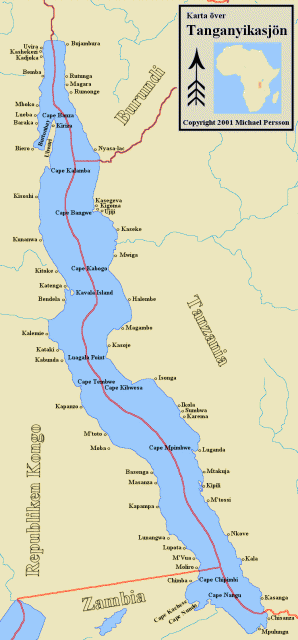Tanganika, Lake
LAKE TANGANIKA IS IN east-central Africa in the Great Rift Valley at an elevation of 2,534 ft (772 m). It is very deep and narrow in typical rift formation with mountains rising out of the lake. According to the Center for Great Lakes Studies, Lake Tanganika is the seventh-largest lake in the world when ranked by area and is the third-largest in the world by volume.
Tanganika is 4,823 ft (1,470 m) deep, making it the second-deepest lake in the world behind Lake BAIKAL in RUSSIA. It is the second-largest lake in Africa, covering 12,700 square mi (32,890 sq km). The lake is 420 mi (680 km) long and up to 45 mi (72 km) wide. It is bordered on the west by the country of CONGO, on the southwest by ZAMBIA, and on the south by both TANZANIA and BURUNDI.
The Malagarasi, Kalambo, Ruzizi, and several other small rivers feed Lake Tanganika. The Ruzizi flows out of Lake Kivu. The Kalambo River is known for having one of the highest waterfalls in the world as it descends 3,000 ft (914.4 m) over 6 mi (9.7 km) through a volcanic gorge. The Kalambo Falls are just one section of this descent in one single spectacular drop of 704 ft (214.5 m). The Lukuga River is the only outlet for Lake Tanganika at Kalema, Congo, on the lake's western side. The Lukuga flows into the CONGO RIVER system, but because it is often clogged with silt it runs only intermittently.

Lake Tanganika, for a very long time, was completely isolated from the rest of Africa's freshwater system. Because of this isolation, there are a large number of fish and other animal species peculiar to the Tanganika area. Up to 25 percent of the 400 species in the area are specific to Lake Tanganika. There is also a large population of hippopotamuses and crocodiles, including the rare sharp-snouted crocodile, swimming in Lake Tanganika. There is a large variety of waterfowl and other birds that live around the lake, including ducks, geese, storks, pelicans, cranes, kingfishers, guinea-fowl, quail, ptarmigan, egrets, fly-catchers, eagles, and more. A great diversity of animals live around the lake including elephants, buffaloes, zebras, antelope, lions, leopards, and chimpanzees. The lake also supports the surrounding agriculture where rice, coffee, sweet potatoes, yams, sugar cane, beans, ginger, cotton, and tobacco are grown.
Shipping and commercial exchange is important on the whole length of Lake Tanganika. Fishing is one of the main economies on the lake with many of the natives still using their dugout canoes to fish from. The major port towns include Karema, Congo; Kigoma, Tanzania; and Bujumbura, Burundi. It takes three to four days to travel the length of the lake in a steam ship. During World War I, there were several small naval battles on the lake between the British and the Germans. In 1871, David Livingstone and Henry M. Stanley explored this area and documented it in their journals.